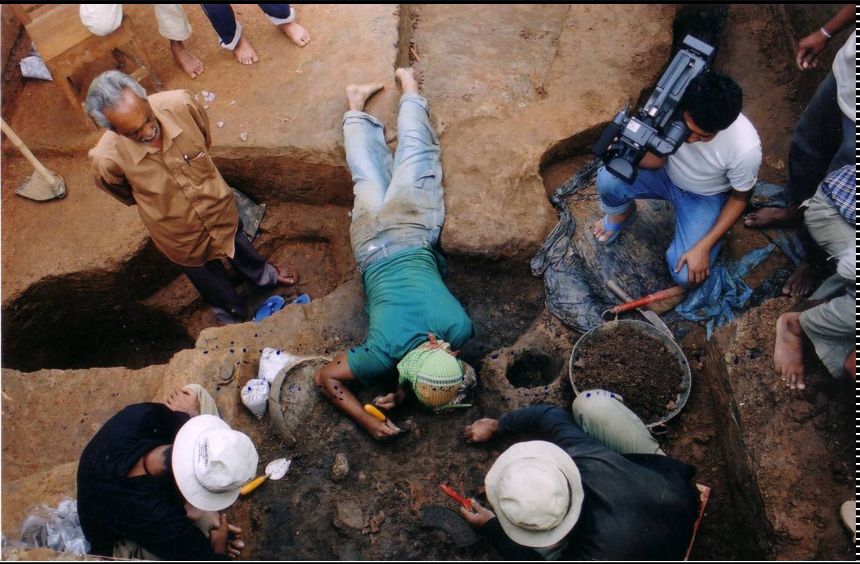Muntakim Haque writes on the lectures by Shahnaj Husne Jahan and Sufi Mustafizur Rahman at Bengal Institute in 2017.
Archaeologist and professor at the University of Liberal Arts Bangladesh (ULAB), Shahnaj Husne Jahan has been navigating the challenging practice of archaeology in Bangladesh for decades. She affirms that in order to understand an ancient culture and their behavioural pattern, everyday objects must be studied; tiny pieces of abandoned rubbish could potentially reveal the culture of an entire civilisation. She described the chronology of invention in cultures both prior to and after contact with other cultures and how these help determine the time and origins of a civilisation along with the influences from other sources. Wari-Bateshwar, Lalmai Hills and Chaklapunji are archaeological sites where neolithic and pre-neolithic tools were already found. These sites could reveal archaeologically significant finds which could point us to a more comprehensive history of the Bengal region.



In a lecture at Bengal Institute, Sufi Mustafizur Rahman, archaeologist and professor at Jahangirnagar University and chief archaeologist in the excavation at Wari-Bateshwar, detailed much of the findings discovered at the site. Wari-Bateshwar is thought to have been established around 5th century BC. It was rediscovered in the 1930s, although excavations didn’t begin until the turn of the new millennium. Thousands of items were recovered from excavations at Wari-Bateshwar. The items ranged from currency and utensils to objects of worship and jewellery. By understanding the composition of these items, the technique they were built with, the way they were stored and their location relative to other objects, the purpose of the objects, the role they played in the lives of the citizens of the city, and most importantly, the way the people lived their lives were extrapolated. Additionally, by examining the craftsmanship and materials used in some of the items found, Mustafizur Rahman has come to several startling conclusions about the connections the city had with other city-sites.
Sufi Mustafizur Rahman believes there is a high possibility that the city traded with the Greeks; it is possible that Wari-Bateshwar was the city the Greek mathematician Ptolemy had referred to as ‘Sounagora’ in his book Geographia. Furthermore he claimed “silver punch-mark coins that are found in Wari-Bateshwar dates back to 6the century BCE, one of the earliest in the world.” In addition to the objects, various ruins reveal the religious practices and way of life of the residents. For instance, multiple temples were found consistent with Buddhist symbolism, so it is thought that most settlers there were Buddhists. In addition to this, an enigmatic structure suspected to be used for meditation was found that has instigated quite the debate over its purpose. These claims have serious implications on how the historic heritage of Bengal is perceived.
There are however hurdles when it comes to the exploration and discovery of historical evidences of Bengal. Shahnaj Husne Jahan claims that there were twenty-five hundred archaeologically significant sites in Bangladesh that are not being excavated. She expressed her dismay at the lack of expertise and effort in conserving archaeological sites in Bangladesh. She is currently working on the excavation of Bhitargarh situated in Panchagarh, adjacent to the Bangladesh-India border. Bhitargarh site is a fort city with an interesting cityscape that is enclosed by a large moat, with a wall guarding the city and another wall guarding the King’s Palace in the city centre. There is yet another large pond inside that compound. Excavations are still going on but the items recovered seem to date to 2nd century BCE. The Center for Archaeological Studies at ULAB routinely excavates the site under Professor Jahan’s guidance. She underlines the importance of supporting and encouraging the local communities to conserve the important sites because the economic circumstance of these communities hinders their ability to help. She adds that there are various types of laboratories needed to assist archaeologists which are unavailable due to lack of funding. The bureaucracy surrounding archaeological research is deeply affecting the findings at Bhitargarh just as other sites in Bangladesh. Mahasthangarh is thought to be one the most vulnerable excavation sites by The World Heritage Fund due to lack of funding to protect the area from rough weather conditions and looting.
“Every stroke of an archaeologist’s brush is really a leaf of a history book as soil preserves all activities within it,” said Shahnaj Husne Jahan in regard to her joy at being involved in the field. In order to understand the evolution of culture, we must understand the evolution and determinant factors of culture like geography, time and natural resources. The tools used in archaeology such as dating methods, soil layer recognition for the identification of eras and precise detectors that model fragile fossil samples, help unveil truths about where we came from and who we are. There can literally and figuratively be no rock unturned, and no surface unbrushed.

